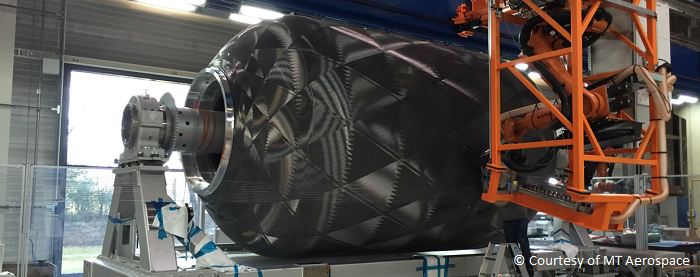Thinking outside the box. You constantly hear and read about it. That’s nothing new. This story takes a totally different approach.
All types of spacecraft need a source of energy. Usually flywheels or rechargeable batteries provide this energy storage. What they both have in common: They take space and are quite heavy.
Back to thinking outside the box; more precisely the frame of the box. Enrico Stoll (ES), the INNOspace Masters Overall Winner of the innovation competition and winner of the German Aerospace Center (DLR) Challenge 2017, came up with a pioneering idea how to store energy in the walls of a spacecraft. If you compare this notion to an e-bike, imagine how much lighter this bike could be if the heavy battery would be integrated into the material of the frame! Learn more about how the innovator came up with his concept, current challenges and what this idea will offer and when we can expect first results.
Short Interview with Enrico Stoll – INNOspace Masters Overall Winner 2017
AZO: Let’s kick-off with a short timeline. When and how did the idea arise/develop?
ES: One of the research foci at the Institute of Space Systems is the performance increase of CubeSats to enable complex tasks, such as debris removal. The idea of combining batteries and structures originated in that framework. Initially we thought of printing batteries, however, in interaction with the Institute of Particle Technology about current battery technologies, the emphasis was changed towards fibre composites and next generation battery systems.
AZO: What are current challenges you are facing?
ES: We have a good understanding of requirements and the boundary conditions that are associated with the project. Now we expand and combine that knowledge to practical preliminary tests. This will help us selecting best material, optimised processes, and develop and mature process chains.
AZO: What are the short- mid- and long-term objectives?
ES: Our short term goal is to develop laboratory samples to prove our idea. Based on that we will develop a prototype within the project mid-term. The long-term goal is to mature the product until it is ready for the market.
AZO: When will we see first results?
ES: We aim at finishing the material and process developments one year after the project kick-off. We hope to have the according laboratory samples available half a year thereafter and use them to develop a prototype in the shape of a CubeSat at the end of the project after two years.
Keeping these objectives in mind, let us have a closer look at the winning idea of the INNOspace Masters, its advantages and the technology transfer aspect.
Wall#E – Fibre Reinforced Spacecraft Walls for Storing Energy
The basic idea of Wall#E aims at integrating energy storage functions into the support structure of spacecraft. For this, it makes use of fibre-reinforced structures – lightweight, high-strength composite materials with great durability and corrosion resistance – infiltrated with state-of-the-art battery materials. Initially, Wall#E focused on satellites, but this concept can also easily be adapted to launch systems, space stations and ground-based e-mobility applications. In this regard, the technology transfer involving the integration of fibre composites and next generation battery systems makes the idea suitable and attractive for multiple application fields.
Major benefits of the awarded idea include:
- Satellite weight reduction
- Lowering launch costs
- Saving energy
- Simpler and more compact constructions
Technology Transfer Offers Cross-Industry Advantages
The INNOspace Masters Overall Winner and winner of the DLR Challenge shows how important innovative ideas are for the competitiveness and development of the space sector and non-space sectors at the same time. Thereby, technology transfer plays a key role and drives cross-industry innovation on a large scale. Not only does it take business ideas to the next level, but also creates benefits for the economy and ultimately the society. It also shows that nearly anyone from any sort of sector is eligible to take part in the INNOspace Masters competition.
These kind of business ideas are exactly what the INNOspace Masters is looking for. Be ready for the next round and get inspired by the winning ideas of previous editions.
About the INNOspace Masters Ideas Competition
Under the heading “Space Moves! – New ideas for the next space generation”, the ideas competition INNOspace Masters is seeking advanced business ideas and concepts, tackling current challenges of the space industry with innovative solutions. Initiated by the Space Administration of the German Aerospace Center (DLR) and organised by Anwendungszentrum GmbH Oberpfaffenhofen (AZO), this competition invites innovators to submit their proposals and concepts for the New Space Economy.
Spin-in as well as spin-off ideas – meaning technology transfer from a non-space sector into space and vice versa – are the main characteristics of the INNOspace Masters and make the competition a unique experience for all its participants. Learn more about the INNOspace Masters, its topic-specific challenges and submit your idea at www.innospace-masters.com.




